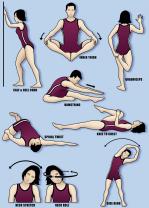s-t-r-e-t-c-h
 Stretching is useful for both injury prevention and injury treatment. If done properly, stretching increases flexibility and this helps reduce risk of injury. A muscle/tendon group with a greater range of motion, will be more mobile and less likely to experience tears when used actively.
Stretching is useful for both injury prevention and injury treatment. If done properly, stretching increases flexibility and this helps reduce risk of injury. A muscle/tendon group with a greater range of motion, will be more mobile and less likely to experience tears when used actively. Please keep in mind that individual health and fitness levels will determine the types of stretches you do. Below are basic guidelines for safe and effective stretching.
-
Warm up prior to stretching. Warming up prior to stretching does a number of beneficial things, but primarily its purpose is to prepare the body and mind for more strenuous activity. One of the ways it achieves this is by helping to increase the body's core temperature while also increasing the body's muscle temperature. By increasing muscle temperature you are helping to make the muscles loose, supple and pliable. This is essential to ensure the maximum benefit is gained from your stretching. A warm-up should be a slow, rhythmic exercise of larger muscle groups done before an activity, such as riding a bicycle or walking. Aim for 5-10 minutes of activity. This warm-up provides the body with a period of adjustment between rest and activity.
-
Stretch gently and slowly. (Avoid bouncing) Stretching slowly and gently helps to relax your muscles, which in turn makes stretching more pleasurable and beneficial. This will also help to avoid muscle tears and strains that can be caused by rapid, jerky movements.
-
Stretch ONLY to the point of tension. Stretching is NOT an activity that was meant to be painful; it should be pleasurable, relaxing and very beneficial. Although many people believe that to get the most from their stretching they need to be in constant pain. This is one of the greatest mistakes you can make when stretching.
-
Breathe slowly and easily while stretching. Many people unconsciously hold their breath while stretching. This causes tension in your muscles, which in turn makes it very difficult to stretch. To avoid this, remember to breathe slowly and deeply during your stretching. This helps to relax your muscles, promotes blood flow and increases the delivery of oxygen and nutrients to your muscles.
